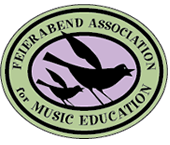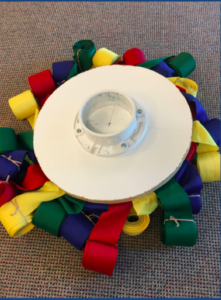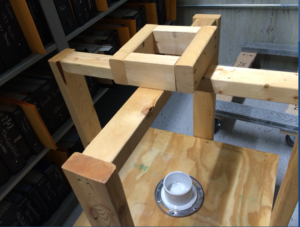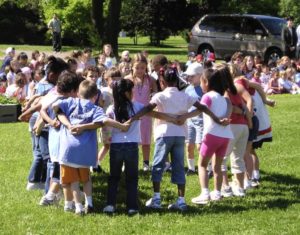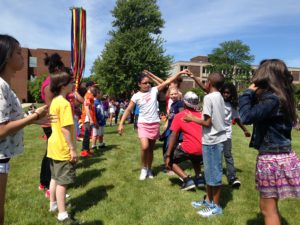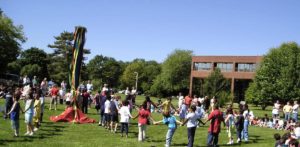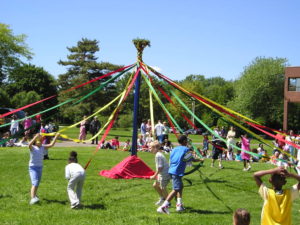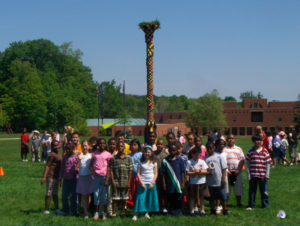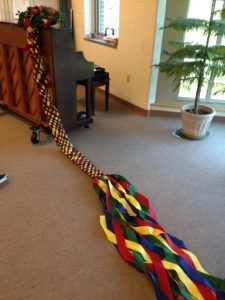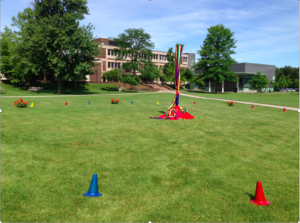BRIDGES TO THE COMMUNITY SERIES: PART 6: MAY DAY
Lillie H. Feierabend, FAME Teacher Trainer
Often a single experience will open the young soul to music for a whole lifetime. This experience cannot be left to chance. It is the duty of the school to provide it.
Zoltan Kodaly, Children’s Choruses, 1929
 I take this charge to heart. Teachable moments do not always happen in the music classroom. Regardless of the excellence of our materials, sequencing and passion, we have no guarantee that students will be moved by music in the short time they are with us. But, if we look just beyond the limits of the music classroom, we can create other experiences capable of engaging and influencing, not only our students, but our greater school community, as well, and most significantly, our families. For more ideas, John’s article, Beyond the Music Class, is included at the end of this article.
I take this charge to heart. Teachable moments do not always happen in the music classroom. Regardless of the excellence of our materials, sequencing and passion, we have no guarantee that students will be moved by music in the short time they are with us. But, if we look just beyond the limits of the music classroom, we can create other experiences capable of engaging and influencing, not only our students, but our greater school community, as well, and most significantly, our families. For more ideas, John’s article, Beyond the Music Class, is included at the end of this article.
This month let’s look ahead to Spring; time to open the windows and let in the fresh air, time to tend to the sprouts in the garden and their promise of abundant color, time to watch for buds on the trees. Time to spring-clean, wash the car, tune up the bike, find the running shoes, and grab the sandals.
It’s also time to take your students outside. One of the greatest joys of working with children is taking them outdoors to sing and dance. Their movements acquire a freshness and a lightness when enjoyed in the open air. There is an extra skip in their step, an extra bounce to their movements. Having May Day is actually quite simple; take any of the dances learned in class and perform them outside. That simple!
Each Spring our entire school journeys outside to celebrate the children and “May Day”.
It doesn’t matter when. Anytime is appropriate, from the traditional May 1st to any day in May, or even June. May Day, for us, is weather dependent and we have been flexible enough to celebrate on a variety of dates. We look for a series of clear dry days and then alert everyone. One May was so rainy, we gathered on June 15.
There is really no “correct” way to celebrate May Day. It is enough to be outside in a community of music makers. You do not even have to have a May Pole, just take your school outdoors on a beautiful sunny day. Even if you do have a pole with ribbons, you don’t have to weave them. A colleague who teaches kindergarten wanted to create a May Day experience for his students but knew that weaving would be difficult for his little ones. His solution? Each child takes a ribbon and they all skip around a few times, skip back to where they began and then dance their dance. Charming!
If you do plan on having a May Pole, here is it in a nutshell; you should have some sort of pole, somehow secured so it doesn’t fall over or rotate, and any even number of ribbons somehow attached at the top. The ribbons are woven by performing the Grand Right and Left around the May Pole. I am happy to share with you what I do. Make your decisions based on what works for you, your students and your situation. You will find that whatever you do will be joyous and wonderful and I guarantee everyone will have a great time.
May Pole
A May Pole can be as simple (and traditional) as a tree trunk or elaborate and expensive. I bought a 12-foot PVC pipe with a 4-inch diameter and painted it blue. A general rule of thumb is that the length of the pole should be twice the length of the ribbons.
Ribbons
Ribbons can be any color, any width, any length, any material. I find that 2 ¼” grosgrain ribbon works best for my durability needs and also fits nicely into young hands. I wanted 24 ribbons, so I bought 50 yards of each of four colors (red, green, blue, and yellow). I cut the ribbons into 25-foot lengths to equal 6 ribbons from each color for a total of 24 ribbons. This works perfectly for a 12-foot pole.
Attach the Ribbons
I bought a one-inch thick wood disk, 16 inches in diameter. I secured (with rivets) the 24 ribbons, alternating colors, around the top edge of the disk and then covered the entire top with artificial flowers using a hot glue gun. In retrospect, I did not need a 16” disk or one that was an inch thick; it would have worked with a smaller, thinner one. Since I was concerned that the held (free) ends of the ribbons would unravel with all the pulling, I dipped the last two inches of each ribbon in Elmer’s glue. After the ribbons were riveted on top, I put the disk on a table and let the ribbons drape over the side so the ends could drip onto newspaper on the floor. They have lasted these past twenty years and still look as good as new.
Connect the Disk to the Pole
Believe it or not, a 4-inch toilet flange works perfectly. It is riveted to the underside of the disk with the riveted ribbons. This makes the head fit snugly onto the PVC pipe, but can be detached from the pipe (with a little elbow grease) for easy storage after our celebration.
Secure the Pole
At one school, I slipped the PVC pipe over an old flagpole. At another school I put the PVC pipe over two badminton stanchions which fit perfectly! Then my good friends and colleagues at Gordon College created the base shown here. Rivet another 4” toilet flange at the bottom of your base for the other end of the PVC pipe and voila! Sturdy, and the pole will not rotate. Anchor the base with a few bags of sand, or a few flats of water or even a few cement blocks, if you have them. I then cover the base with red tablecloths and pots of flowers.
Performance
Everyone begins walking to the designated site at about 9:30. We begin at 10 with everyone singing the May Day Carol from John Langstaff. We dance from youngest (K) to oldest (5th) and then 24 students weave the Maypole. To help with time considerations, the kindergarten students go directly to the dance area and sit there while everyone else is finding a space, putting down blankets and getting situated. When the Ks are finished dancing, they simply go to their designated seating area (which we cone off) while the 1st grade students get up and come to the dance area. The entire celebration takes about an hour with each successive grade coming into the dance area while the previous grade is returning to their sitting spot. This time frame works well for us; not so early that the grass is still wet, but not so late that we run the risk of uncomfortable heat and humidity. Teachers bring blankets or tarps for the students to sit on and parents bring blankets and lawn chairs.
The PreK join us but do not dance; they bring juice boxes and crackers and have a great time watching the dances and being outdoors. One of my favorite memories is of three PreK students imitating some of the fourth-grade dance figures. This is the way children learn best, watching, imitating and experimenting.
The Dances
The students perform (on grade level) a dance that was learned in the classroom. Through the years, we have performed circle dances, Sicilian circle dances, longways formations, and even expressive movement (Move It!). All children dance. Occasionally, an aide or teacher has carried a child or pushed a wheelchair. An appropriate dance can always be found. My favorite resources are, The Amidons (Chimes of Dunkirk, Listen to the Mockingbird), John Feierabend (Move It!, Move It! 2), Paul Kerlee (Welcome in the Spring: Morris Dances for Children), Sanna Longden (Favorite Folk Dances and especially her video, Maypole and Mexican Dances). Martha Chrisman Riley (English Country Dances for Children), and Phyllis Weikart (Teaching Movement and Dance, with Rhythmically Moving/9 corresponding CDs). I usually poll the grades to see which dance they would like to do on May Day. Here is a typical May Day repertoire list.
Basketweave
Circle Dance
All Sing
May Day Carol
John Langstaff, A Revels Garland of Song
Kindergarten
Chimes of Dunkirk
Amidons, Chimes of Dunkirk
First Grade
Doudlebska Polka
Weikart, Teaching Movement and Dance, CD2
Second Grade
Basketweave Dance
Amidons, Mockingbird
Third Grade
Bridge of Athlone
Riley, English Country Dances for Children
Fourth Grade
Durham Reel
Amidons, Chimes of Dunkirk
Fifth Grade
Mariposa
Amidons, Listen to the Mockingbird
OR
Boston Tea Party
Amidons, Listen to the Mockingbird
May Pole Weaving
Ralph Vaughan Williams
Folk Songs of Somerset
Two additional favorites:
Ribbon Dance
Riley, English Country Dances for Children
Three Meet
Riley, English Country Dances for Children
Morris Sword Dancing
I have never done this for May Day but would highly recommend looking into it. I have a dear colleague who is an expert and has been teaching Morris Sword Dancing to her students (and colleagues!) for decades both at school and at music camps. You Tube will give you a good idea of how strenuous and vigorous it can be (for adults), but it is quite accessible and exciting for students of all ages. Students are always inspired when they see one of the videos. The “swords” can be as simple as yard sticks. Paul Kerlee’s book/CD (Welcome in the Spring: Morris Dances for Children) is a great resource.
Weaving the May Pole
I always use Folk Songs of Somerset by Ralph Vaughan Williams for the weaving of the May Pole. I’ve included my May Day Dance at the end of this article, but as always, do what is most appropriate for you, your students and your community. Sanna has several very good ideas for weaving in her wonderful video. Since I teach the Grand Right and Left in second grade as part of our curriculum, it is usually a second-grade class that does the weaving. I don’t select any particular student or class. My colleagues and I try to reward a class that has worked particularly well together through the year or through cooperation, has overcome hardships; a class that has learned the importance of teamwork. Since we have twenty-four ribbons, we usually have twenty-six or twenty-seven students practice since there may be absences on May Day. If there are not, we simply have a few ribbons with two weavers who work cooperatively. This is addressed as we practice.
The weavers “practice” four or five times before May Day; a few during class, but we don’t really take extra time to “perfect” anything. They simply dance the Grand Right and Left in various ways (I’ve included these under Hints along with the dance directions), and then a few with the May Pole in our gym. This is important. The gym offers the opportunity to practice with the actual ribbons and as importantly, to experience far more appropriate spacing than my room can provide. There is a world of difference when performing the Grand Right and Left in a ten-foot classroom circle and performing it fifty feet apart!
The Secret!
The goal is not to “catch up” to the person in front. The goal is to collectively and consistently walk a steady beat with normal size steps. This will keep pacing and spacing even. That is why music with a clear and steady beat is so important. Ideally each student should consistently remain across the pole from the same person.
Weaving
To Unweave or Not?
Older students can certainly unweave the ribbons at the end of the Grand Right and Left, but this takes time and unlike the weaving, where you don’t need to look at the pole for guidance, you do need to look at the pole when unweaving. I prefer to let everyone, especially the weavers enjoy the beauty of their hard work and focus. It is a stunning visual representation of community and cooperation and should be celebrated.
So, we detach the pole from the base and pull off the head with the ribbons, still woven, for all to admire. It takes me about thirty minutes to “unweave.” I sit and begin pulling a ribbon about three feet from the bottom. I pick another ribbon and begin pulling that until it is free, until little by little, there is more and more wiggle room and it quickly unravels.
Everything comes apart quite easily for storage; the base is kept in a storage room, the pole leans against a wall in my classroom and a box holds the head with the ribbons and attached flange. Since I don’t want my ribbons to get wrinkled, I roll each ribbon into a spool, and secure it with a rubber band, ready for the next group of students, next year.
Braiding the May Pole
The Grand Right and Left is not the only way to weave ribbons; there are patterns where half the group walks or skips in one direction while the other half moves in the opposite direction (Barber Pole), and patterns that feature the Do-Si-Do with a partner and then with a corner (Diamonds/Spider’s Web), and patterns where three people weave with each other (Braid and Weave). I have included directions for these three below but once you begin to look for more, you will find many, especially on You Tube. You will also find motivation, inspiration, history, and most importantly, directions! There are patterns for all abilities and don’t forget to adapt and modify for the needs and abilities of your students.
Barber Pole: Easiest
Count off 1s and 2s. 1s take two steps in, toward the pole while 2s remain where they are, instantly creating two circles (1s on the inside and 2s on the outside). 1s turn to skip clockwise and 2s turn to skip counterclockwise. Try to keep spacing even and 2s (outside circle) make sure to hold ribbons a bit higher. When done, turn in opposite direction to unwind.
Barber Pole: More Advanced
Regardless of the number of people, number in consecutive order. For example, I’ll use 24. 1-12 turn to move in one direction(clockwise) and 13-24 turn to move in the other direction (counterclockwise). All walk on the beat toward each other. One team steps slightly in (toward the pole) so as not to run into each other. When the leaders of each team meet, they switch from inside to outside or outside to inside. When they meet again, they switch again. Continue until the ends of the ribbons, then all turn to unwind.
Diamonds/Spider’s Web:
This lovely pattern is created by the interaction of three people (Do-Si-Do partner, Do-Si-Do corner/neighbor). Pair off by As and Bs and face each other; this is Partner #1. Do-Si-Do with Partner #1. Turn to the person on the other side (corner/neighbor); this is Partner #2. Do-Si-Do with Partner #2. Continue this alternating pattern until you reach the ends of the ribbons. It’s important that students know the Do-Si-Do very well first; the addition of ribbons will require a different up and down motion for each of their two partners, and moving backwards with the ribbons may prove challenging, as well.
Braid and Weave
Number students 1, 2, 3 clockwise. Each #3 walks in front of their #2 then behind their #1 and stops on the right of their #1. Next, #2 walks in front of their #1 then behind their #3 and stops on the right of their #3. Last, #1 walks in front of their #3 then behind their #2 and stops on the right of their #2. They will now be in correct order, ready to begin again. Each line of three will move slightly to the right with each rotation. Repeat until all strands are braided (if you use 24 ribbons, there will be 8 braided strands). Have each group of three turn and face the next group of three. Working as a team, perform the Grand Right and Left. When done, turn to unweave the eights strands, then unbraid the groups of 3.
Community
Through the years, this celebration has taken on additional meaning and tradition. Some years, we find May Day baskets on our classroom doorknobs, created and delivered by the first-grade students. Some years, older classes buddy up with younger classes and spend the afternoon together in shared activities. Sometimes, kindergarten parents are invited to stay for lunch. It’s wonderful to see how May Day brings out the creative and community centered ideas from everyone.
Everyone should have fun with May Day. It’s wonderful to watch the youngest students as they gaze in awe while older students dance intricate patterns and beautifully weave the May pole. It’s also delightful to observe how older students cheer on the younger students, remembering when they too were just learning some of the dances. And younger students are always excited when a new dance is introduced in class that they have seen an older grade perform at May Day. Since all the dances are age appropriate, the developmental sequence and layering of skills can easily be seen by all, again demonstrating the strength and importance of our sequenced curriculum.
It is as true today as it was eighty-three years ago, and for millennia prior to that…and will be for millennia to come. Kodaly summed it up beautifully,
Singing is the instinctive language of the child, and the younger he is the more he requires movement to go with it…the organic connection between music and physical movement is expressed in singing games. These, particularly in the open air, have been one of the principle joys of childhood.”
Zoltan Kodaly, Singing Games, 1937
Here’s an interesting thought. Howard Gardner wrote Frames of Mind in 1983. In it he posited that all human beings possess a portfolio of intelligences, Music being one of them. Here is the quote again, with his Multiple Intelligence labels….
Singing (Musical) is the instinctive language of the child, and the younger he is the more he requires movement (Bodily-Kinesthetic) to go with it…the organic connection between music and physical movement is expressed in singing games (Verbal Linguistic, Logical Mathematical, Interpersonal, Intrapersonal, Visual-Spatial). These, particularly in the open air (Naturalist), have been one of the principle joys of childhood.”
MAY DAY DANCE
Lillie H. Feierabend
Music, Vaughan Williams, Folk Songs of Somerset (about 4 minutes)
Beats (in succession) circle of students, numbered 1, 2, 1, 2, 1, 2…. in pairs each hold a ribbon; face the maypole
- 8 Introduction
- 16 facing the pole, all sashay sideways to the left; remind students to stay evenly spaced
- 16 all sashay sideways to the right, back to original position 16
- 16 while 2s remain stationary, all 1s take one step into the circle and sashay sideways to the left (2s hold ribbon a little higher so 1s don’t run into them)
- 16 all 1s sashay sideways to the right, back to original position in the circle (they should angle back between the 2s; remind them to keep the correct spacing)
- 16 while 1s remain stationary, all 2s take one step into the circle and sashay sideways to the right (1s hold ribbon a little higher so 2s don’t run into them)
- 16 all 2s sashay sideways to the left, back to original position in the circle (they should angle back between the 1s; remind them to keep the correct spacing)
- 8 1s hold ribbons high and flutter; 2’s hold ribbons low and flutter
- 8 switch levels
- 16 everybody just flutter ribbons up and down; this is a good opportunity for everyone to think about which way they will turn and if they will hold their ribbons high or low
- drum roll everyone turn and face partner (each 1 faces their 2)
1s face CW, 2s face CCW
1s hold ribbon high to walk outside first; thinking “up and out”
2s hold ribbon low to walk inside first; thinking “down and in” - 4 ready
- to end grand right and left
begin walking and of course, switch thoughts and actions to pass the next person
weave until music ends; children turn to face May Pole, drop
their ribbons and walk back a few steps to see their beautiful
weaving
HINTS
Children should try not to look at the may pole while weaving.
Children should have code words like “up, down” or “in, out” to help them with the alternating pattern.
Practice the grand right and left without ribbons first: 1) grasping hands, 2) swinging arms and just brushing hands, 3) swinging arms without touching hands, 4) pretending they are holding a ribbon
Have children hold the ribbon in two places; one hand about two feet from the end and the other hand near the end; that way, if one hand loses the ribbon all is not lost.
Tell children to keep going; do not stop; try to get back into the “in-out’ sequence.
Pull the ribbon slightly; the more weight, the tighter the weave; taut, but not hard enough to pull the pole over.
Remind children to keep spacing as even as possible while sashaying. There is no “passing.”
Remind children to walk on the beat and not try to hurry and “catch up” to the person in front of them.
This is just what I do. Please feel free to adapt and create your own wonderful May Day memories.
Enjoy! It will be beautiful!
___________________________
Beyond the Music Class:
Expanding the Musical Influence of the Elementary School
John Feierabend
“Often a single experience will open the young soul to music for a whole lifetime. This experience cannot be left to chance. It is the duty of the school to provide it.”
Zoltán Kodály: Children’s Choruses, 1929
A few miles from the University of Hartford there is a mid-sized, middle class suburban town with four public schools; a Pre K-3rd grade school, a 4th grade-6th grade school, a junior high for grades 7 and 8 and a high school. It is the Pre K-3rd grade school that has caught my attention-how a whole school, and especially a music teacher and principal, can take advantage of the many opportunities to open a young soul to music.
This week, as the buses arrive and students enter the building from 8:15 to 8:30 a.m., they are hearing Barber’s “Adagio for Strings” playing through the intercom. Classes officially begin at 8:50 a.m., but until then, students will hear music from a variety of genres, most often from the masterpieces of classical literature. There are no pretenses about Mozart making the kids smarter, only a principal and faculty who want the students to encounter these important musical experiences. The same tape will be played every day for two weeks so the students have a chance to gain some familiarity with the pieces; many can be found singing or humming themes throughout the day.
During this card marking, the third grade students will come into the gym every Monday morning from 8:30 to 8:50. While the rest of the school is preparing for their day with classical music, these third-grade students will be folk dancing with the music teacher. During the next card marking, a different grade will have their turn at morning dancing.
This week is the first Friday of the month, so the entire student body is assembled in the gym for the “All School Sing.” Some of the songs are favorites from one of the grades; other songs are taught to the group en masse. Color transparencies of “Mommy Buy Me a China Doll” have been made and are projected on the wall as the music teacher sings the story to end the “sing.”
Children in the youngest music grades are given an “Ask Me” sheet to take home once a week. This is a sheet of paper that is to be presented to the parents when the child gets home. “Ask me about my silly horse,” was last week’s sheet. On the sheet were the words to “The Horse Stood Around” and instructions for the parents to “Ask your son/daughter to teach you this song and the game that goes with it.”
During library time the students are given the opportunity of borrowing from the Music Lending Library, which is housed in the main school library. The librarian and music teacher have assembled hanging plastic bags containing folksong picture books and accompanying cassette tapes, quality music videos, and other exemplary audio cassette tapes. Many of these have been experienced in the music classes; others are for extended discovery. Initially, funding for this program came from the PTA. Now, a portion of each year’s school music budget is used to enhance the collection.
The “Parents as Teachers” program is once again in full swing. Designed for parents of children who are not yet of school age, the weekly meetings with educational specialists present activities that parents and children can share so as to help their children be ready for school by age five. As part of this program, parents and children (birth to age 5) are invited to attend music and movement classes twice a month. These classes are sometimes scheduled before or during the school day; other years the classes have been scheduled after the regular school day has ended. These lucky children will soon be musically ready for kindergarten.
In the autumn the first of two annual Family folk Dances will occur in the gym on a Friday night. Children and their families will do play parties and dance folk dances from around the world. This fall’s dance is being held in conjunction with a school-wide spaghetti dinner. Although the dancing will continue from 6:30 to 8:00 p.m., the families will come and go as they take their shift attending the dinner.
During “Music in our Schools” month, one week is designated for parents to share their child’s music class. Parents participate fully with their children in all of the activities that would normally occur, including active movement activities, pitch matching ones, call and response songs and play parties. This week-long musical celebration predominates in the second Family Folk Dance of the year.
In the spring, rather than spend many weeks rehearsing a few songs for a musical show, the children are learning country dances and song to be shared during the May Day celebration. Parents and children on Thursday morning at 10:30 with blankets to sit on the hill behind the school and watch as each grade presents the dances and songs they have learned as part of their curriculum that year. All eagerly await the third grade, who have the annual honor of performing the May pole dance. Each year the final result elicits the same awed reaction from students and parents alike.
But the year of music isn’t over. The music teacher has prepared a short tape of twenty to thirty songs for each grade-song that they have learned during the year, with copies for every student. (Blank tapes are purchased in bulk from a tape distributor at a price of about fifty cents a piece and the recordings are duplicated on the district’s high-speed tape duplicator. Summer weeks will be filled with kindergarten children listening and singing “Frog in the Meadow” or “Oh My, No More Pie,” while third grade students will hear on their tape, “Four Skaters” or “Jolly is the Miller.” Parents eagerly look forward to the new tape their child will bring home, anticipating its contribution to the summer’s family car trips. When the next school year begins, these students will be ready to continue where they left off, without needing a long period of musical reawakening.
All of this in addition to music twice a week for 30 minutes.
Any one of these ideas might serve as the “single experience” to open the young soul to music for life. This school is not leaving these experiences to chance but is taking seriously its duty to provide. I am especially proud that these fine ideas are in action at a school where the music teacher is my wife. I hope some of her ideas will inspire others as much as they inspire me.
Reprinted from the Fall 1997 issue of the Kodály Envoy.
http://www.giamusic.com/bios/feierabend
GIA Publications,Inc. | 7404 South Mason Avenue | Chicago, IL 60638
(800) GIA-1358(442-1358) | (708) 496-3800 | Fax: (708) 496-3828
Copyright © 2012 GIA Publications, Inc.
